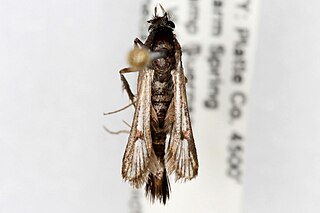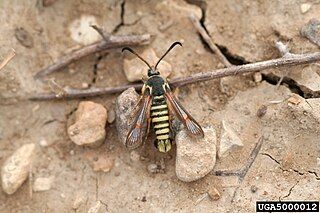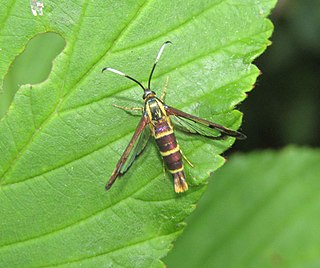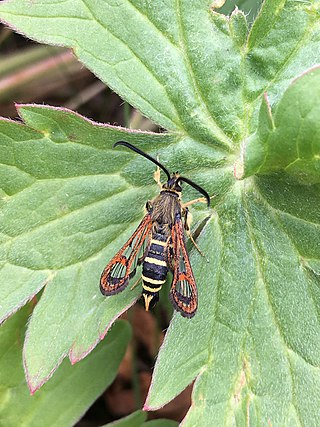
Carmenta is a genus of moths in the family Sesiidae.
Carmenta mimosa is a moth of the family Sesiidae. It is native to Central America, but has been introduced to the Northern Territory of Australia in 1989.

Carmenta mimuli, the coronopus borer, is a moth of the family Sesiidae. The dark form is the typical form and is found in Arizona. The whitish form is non-typical and is known from the south-western United States, from Kansas to Arizona.
Carmenta arizonae is a moth of the family Sesiidae. It was described by William Beutenmüller in 1898. It is known from the US state of Arizona.

Carmenta bassiformis, the eupatorium borer moth or ironweed clearwing moth, is a moth of the family Sesiidae. It was described by Francis Walker in 1856, and is found in the United States from Massachusetts to Florida, west to Wisconsin, Kansas and Texas.
Carmenta corni, the aster borer moth, is a moth of the family Sesiidae. It was first described by Henry Edwards in 1881. It is known in North America, including Wisconsin.

Carmenta giliae is a moth of the family Sesiidae. It was described by Henry Edwards in 1881, and is found from western Alberta to north-western British Columbia, south to Arizona and New Mexico. The habitat consists of mid-to-high elevation montane meadows.

Carmenta ithacae is a moth of the family Sesiidae. It was described by William Beutenmüller in 1897. It is known from North America, including Florida, Arizona, Illinois, Michigan, Nebraska, New York, Virginia and Wisconsin.
Carmenta mariona is a moth of the family Sesiidae. It was described by William Beutenmüller in 1900. It is found in the United States from Montana, south to Arizona and east to Kansas.
Carmenta odda is a moth of the family Sesiidae. It was described by W. Donald Duckworth and Thomas Drake Eichlin in 1977. It is found in the United States from South Carolina to Florida.
Carmenta ogalala is a moth of the family Sesiidae. It was described by Engelhardt in 1946. It is known from Colorado.
Carmenta phoradendri, the mistletoe borer, is a moth of the family Sesiidae. It was described by George Paul Engelhardt in 1946. It is known from south-eastern Arizona and southern Texas in the United States and from Mexico.
Carmenta prosopis is a moth of the family Sesiidae. It was described by Henry Edwards in 1882, and is known from northern Mexico, and south-western United States.
Carmenta suffusata is a moth of the family Sesiidae. It was described by George Paul Engelhardt in 1946. It is known from the United States, including Florida, Oklahoma and Kansas.
Carmenta texana, the Texana clearwing moth, is a moth of the family Sesiidae. It was described by Henry Edwards in 1881 and is known from the US states of Texas and Florida.

Carmenta verecunda is a moth of the family Sesiidae. It was described by Henry Edwards in 1881, and is known from the United States, including Colorado, Utah, California and Arizona.
Carmenta wellerae is a moth of the family Sesiidae. It was described by W. Donald Duckworth and Thomas Drake Eichlin in 1976. It is known from southern Arizona in the US and northern Mexico. The habitat consists of mountains and foothills.
Carmenta theobromae, the cocoa fruit borer, is a moth of the family Sesiidae. It was described by August Busck in 1910, and is known from Colombia and Venezuela.
Carmenta laurelae is a moth of the family Sesiidae. It was described by Larry N. Brown, Thomas D. Eichlin and J. Wendell Snow in 1985, and is known from the US state of Florida.
Carmenta chromolaenae is a moth of the family Sesiidae. It is native to Venezuela, but was introduced to South Africa for the biological control of Siam weed.




